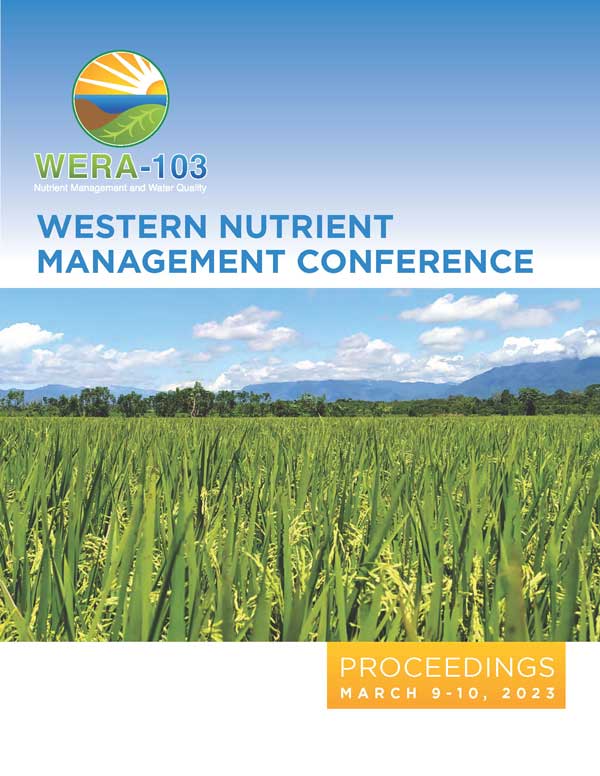Download the Conference Proceedings
Proceedings
Authors
| Filter results8 paper(s) found. |
|---|
1. Is Cover Crop Species Mixture and Diversity More Important at Building Soil Health than Shoot Biomass in a Semi-arid Region?Cover crop mixtures (CCMs) as partial fallow replacements have the potential to increase soil health, yet long-term studies on CCMs, especially in semi-arid environments are relatively rare. An eight-year study at two locations in semi-arid Montana sought to evaluate the effect of functional group (N fixer, tap roots, fibrous roots, brassicacae) and species richness (2, 6, and 8 species in a mix) on a range of biological, physical and chemical soil parameters. Although several soil health... P. Miller, C. Jones, C. Zabinski, K. D'agati, M. Housman, S. Tallman |
2. Cover Cropping in the Semi-arid West: Effects of Termination Timing, Species, and Mixtures on Nitrogen Uptake, Yield, Soil Quality, and Economic ReturnSummer fallow still dominates some areas of the northern Great Plains (NGP), providing an opportunity to grow a partial season cover crop for increased soil health or nutrient availability. Over 12 years of research on single species cover crops in semi-arid Montana have revealed the benefits of early termination and multiple cover crop cycles on N availability, subsequent crop yield, soil health, and economic return. Due to high N fixation, pea cover crops have fairly consistently increased subsequent... C. Jones, P. Miller, S. Tallman, M. Housman, C. Zabinski, M. Burgess, J. O'dea, A. Bekkerman |
3. Effect of Nitrogen Rate and Cropping System on Soil Nutrient Levels in a Long-term StudyDiversified continuous cropping systems in semi-arid regions of the northern Great Plains may enhance sustainability. A study initiated in 2000 in southwest Montana was designed to evaluate crop productivity and economic returns for no- till and organic rotations that included small grains, pulses, and oilseeds. Our specific objective presented here was to compare soil nutrient differences from 2004 to 2012, to learn if economically superior rotations were building or depleting soil nutrients.... C. Jones, P. Miller, T. Rick, A. Mccauley |
4. Measured and Predicted Temporal Changes in Soil Nitrate-n Levels from Late Summer to Early Spring in MontanaMost soil sampling is conducted from August to November in Montana because of better soil sampling conditions and because it provides more time for growers to make fertilizer decisions prior to application. Fertilizer guidelines in Montana are based on spring nitrate-N levels in the upper 2 ft because they are more indicative of growing season available N than fall nitrate-N levels. It is not known how much nitrate-N levels change between late summer and spring, nor is it known what factors affect... C. Jones, A. Lenssen, C. Chen, K. Mcvay, B. Stougaard, M. Westcott, J. Eckhoff, J. Weeding, M. Greenwood |
5. Phosphorus Dynamics in Organic Matter-amended SoilsGenerally, phosphorus (P) is considered immobile in calcareous soils. Yet, numerous studies have found that the addition of organic wastes (e.g. manures) can enhance P mobility in these soils. We believe that the soluble organic matter present in these wastes increases P solubility by inhibiting the sorption of inorganic P on soil colloidal surfaces and subsequently preventing the formation of insoluble calcium phosphates. This results in increased P bioavailability. Likewise, tests used to assess... P. Grossl, R. Koenig, C. Jones, S. Trolove |
6. Economic Model to Determine Optimum Nitrogen Rates for Small GrainsNitrogen (N) fertilizer is generally the highest input cost for Montana grain growers; therefore, it has become imperative that a tool be developed to assist crop advisers and farmers in determining economically optimum N rates (EONR). Data from all available MSU-conducted N fertility trials were gathered for spring wheat, winter wheat, and barley. Only the data sets for dryland fields following fallow were deemed large enough to have confidence in any resulting models, and all other data were... C. Jones, D. Griffith, G. Jackson |
7. Tillage Effects on Phosphorus AvailabilityVertical stratification of phosphorus (P) has been documented in both no-till and reduced tillage systems, yet very few studies have determined if this stratification has affected P uptake, and none of these studies have been conducted in Montana. Stratification of P was compared in 1.2 in layers in a small plot study composed of four tillage systems: long-term conventional (sweep) till (CT), 10-yr no-till (NT), 1-yr NT and 1-yr CT. Olsen P was measured in the upper 12 in., and a sequential extraction... C. Jones, K. Neill, C. Chen, E. Allison |
8. Evaluation of Soil Sulfur Tests for MontanaThere are no sulfur (S) fertilizer rate guidelines in Montana due to inconsistent yield responses, high S soil levels in many regions, a minimal number of S fertility trials in the state, and the lack of Montana and regional data that identify the best soil S tests to use. A study was initiated in 2023 to fill this research void. Three crops (spring canola, pea, and wheat) were grown at three sites, and fertilized with 0, 7.5, 15, and 30 lb S/ac using two S sources (potassium sulfate, gypsum)... C. Jones, P. Miller, P. Carr, S. Koeshall, S. Fordyce, J. Souza, J. Vetch |
